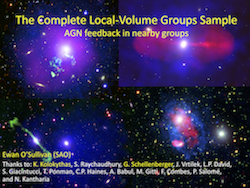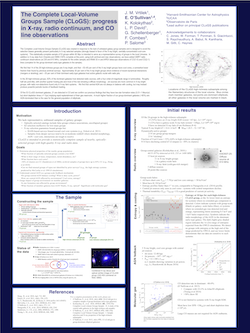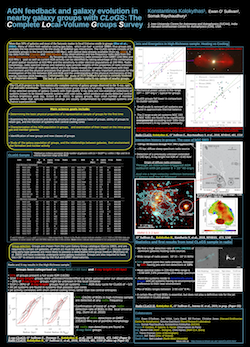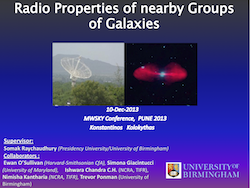Data Products
Publications
- The Complete Local Volume Groups Sample - I. Sample Selection and X-ray Properties of the High-Richness Subsample (O'Sullivan et al. 2017a) describes the sample selection process and results from the X-ray analysis of the 26-group high-richness subsample. The paper discusses the fraction of groups with group and galaxy-scale X-ray halos, cool cores, evidence of mergers, and central radio jet sources, and the relationships between these properties. It also discusses the lack of high-entropy groups in the sample, the tendency for the lowest mass groups to have central temperature peaks, and the lessons that can be drawn from CLoGS for future X-ray group surveys.
- The Complete Local volume Groups Sample - II. A Study of the Central Radio Galaxies in the High-Richness subsample (Kolokythas et al. 2018) focuses on the radio properties of the dominant galaxies of the 26-group high-richness subsample, making use of our multi-wavelength low-frequency GMRT radio observations. 24 of the galaxies are detected in the radio, with 23% hosting AGN jets and another 15% diffuse radio source of uncertain origin; the remainder are point-like. We show that radio jets are more common in X-ray bright groups, and identify two systems whose exceptionally powerful AGN outbursts are delivering 100x more power into the intra-group medium than is being lost by radiative cooling.
- The Complete Local Volume Groups Sample -- III. Characteristics of group central radio galaxies in the Local Universe (Kolokythas et al. 2019) follows on from paper II, describing the radio properties of the dominant galaxies of the low-richness groups, and the sample as a whole. We detect radio emission in 46 of the 53 galaxies, of which 25% host radio jet sources and another 9% diffuse radio emission. We find a correlation between radio morphology and the dynamical youth of the groups; while jet sources are found in dominant galaxies regardless of the group spiral fraction, radio point sources are more commonly found in the dominant galaxies of spiral-rich systems.
- The Complete Local Volume Groups Sample -- IV. Star formation and gas content in group-dominant galaxies (Kolokythas et al. 2021) uses FUV and NIR data to investigate star formation in the group dominant galaxies. Whereas in massive clusters star formation seems to be largely driven by cooling from the ICM, most dominant galaxies of CLoGS groups have very low star formation rates, even when they are embedded in hot gas halos with short cooling times. The exceptions are a subset of lenticular galaxies which show recent star formation and host significant cold gas reservoir, but are located in X-ray faint groups. In these systems, mergers or tidal interactions seem a more likely driver for star formation than cooling from the IGM.
- Cold gas in group-dominant elliptical galaxies (O'Sullivan et al. 2015) and the follow-up paper, Cold gas in a complete sample of group-dominant early-type galaxies (O'Sullivan et al. 2018b) use CLoGS as a basis to examine the molecular gas content of group-central early-type galaxies. Having surveyed all 53 CLoGS group-dominant galaxies with the IRAM 30m and APEX telescopes, we find a relatively high detection rate for CO, but a short depletion time (despite low star formation rates) indicating that group-central galaxies must replenish their molecular gas reservoirs on timescales ~100 Myr. We also find that a much higher fraction of group-dominant galaxies are AGN (rather than star formation) dominated compared to the general population of early-type galaxies, and that at least half the dominant galaxies contain HI as well as molecular gas
- Gas condensation in Brightest Group Galaxies unveiled with MUSE (Olivares et al. 2022) uses MUSE IFU observations of 18 high-richness CLoGS group-dominant galaxies to look at their ionized gas component. In X-ray bright systems several examples of filamentary nebulae and small-scale disks are found, morphologies consistent with predictions for gas condensing out of the intra-group medium. Some larger scale disks and rings in X-ray faint groups may condensed material or perhaps the remnants of past gas-rich mergers.
- Merger histories of brightest group galaxies from MUSE stellar kinematics (Loubser et al. 2022) uses the same MUSE IFU data to examine the state of the stellar component of the 18 group-dominant galaxies, and to draw conclusions about their formation history. The slow rotators are mainly located in X-ray bright groups and show signs of cooling from the intra-group medium, while the fast rotating galaxies tend to lie in X-ray faint systems and are more likely to show evidence of cold-gas-rich mergers or interactions.
- Spatially-resolved properties of early-type group-dominant galaxies with MUSE: gas content, ionisation mechanisms and metallicity gradients (Lagos et al. 2022), the third paper based on the MUSE data, uses emission line ratios to measure metallicity gradients in the warm gas and determine its ionization state. From these results it draws conclusions on the origins of the gas, which appears to be a mix of accretion/mergers and cooling from the hot halo.
- Diversity in the stellar velocity dispersion profiles of a large sample of Brightest Cluster Galaxies z<=0.3 (Loubser et al. 2018) uses a subset of the CLoGS to compare the velocity dispersion profiles of group and cluster-dominant galaxies, showing a correlation between velocity dispersion gradient and galaxy luminosity which may not be replicated in galaxy-formation simulations.
- Evidence of AGN feedback and sloshing in the X-ray luminous NGC 1550 galaxy group (Kolokythas et al. 2020) is a detailed study of one of the X-ray brightest nearby groups, around NGC 1550. Our radio and X-ray analysis reveals previously unknown asymmetric radio lobes, whose structure has been shaped by the sloshing motions of the group core. Though prior studies have treated this system as undisturbed and relaxed, we showed that it has likely undergone a recent minor merger.
- The origin of the X-ray, radio and HI structures in the NGC 5903 galaxy group (O'Sullivan et al. 2018a) examines the complex multi-phase structures in the low-richness CLoGS group NGC 5903, in an attempt to determine the interaction history of the group member galaxies. We report the first detection of an extended, X-ray bright hot intra-group medium, whose disturbed morphology is closely correlated with the previously detected steep spectrum diffuse radio source and 110-kiloparsec tidal HI filament, suggesting a series of gravitational encounters between the group members.
- Initial results from CLoGS were also presented in two conference proceedings papers, O'Sullivan et al. (2014) and Kolokythas et al. (2014), based on presentations at The Metrewavelength Sky conference in Pune, India, December 2013.
Conference Talks and Posters
Slides from the CLoGS talks given by Ewan O'Sullivan at
The Metre Wavelength Sky II (
upper left) and Konstantinos Kolokythas at
The Metrewavelength Sky (
lower left). CLoGS posters presented at the 2019 AAS HEAD meeting in Monterey, by Jan Vrtilek (
centre) and at the
The Metre Wavelength Sky II by Konstantinos Kolokythas (
right). Click to download PDF versions.
Example Images
Some example images from our first
XMM-Newton dataset, showing LGG 402, are shown below.
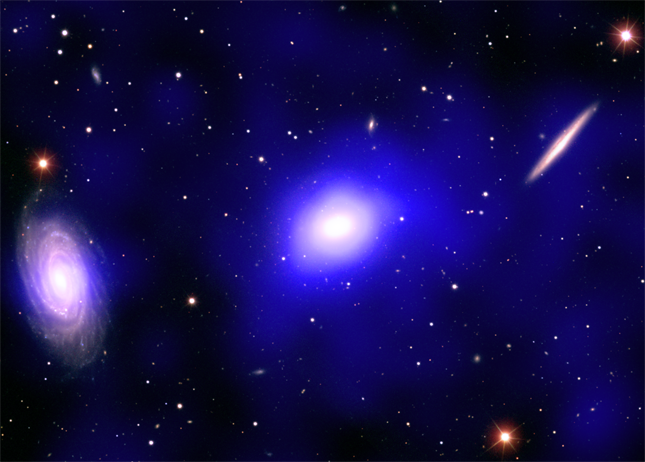
|
Smoothed XMM-Newton X-ray emission in blue, overlaid on an SDSS u,g,r,i composite optical image. We are able to trace the physical properties of the intra-group gas (temperature, density, entropy, etc.) out to around 85 kpc.
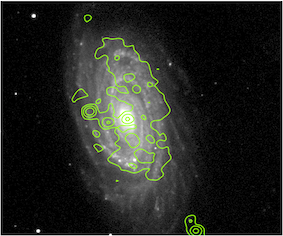 |
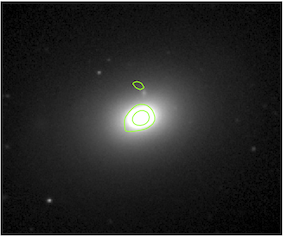 |
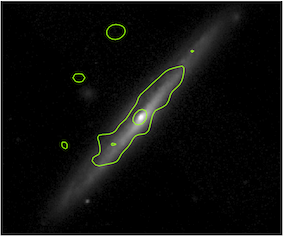 |
GMRT 610 MHz radio contours (c/o Konstantinos Kolokythas) overlaid on optical images of the three main galaxies. Contours start at 270 microJanskys (3 x r.m.s.) and increase by factors of 2. The Seyfert nucleus of NGC 5985 (left) is clearly detected in X-ray and radio, and the AGN in NGC 5982 (centre) also shows up as a radio source. The diffuse radio emission is detected from the disks of NGC 5985 (left) and NGC 5981 (right) is a product of the ongoing star formation in these galaxies.
